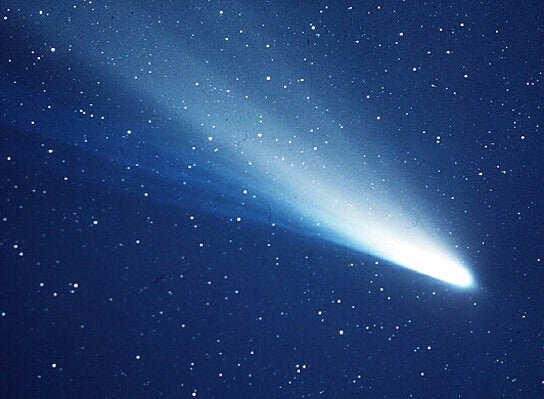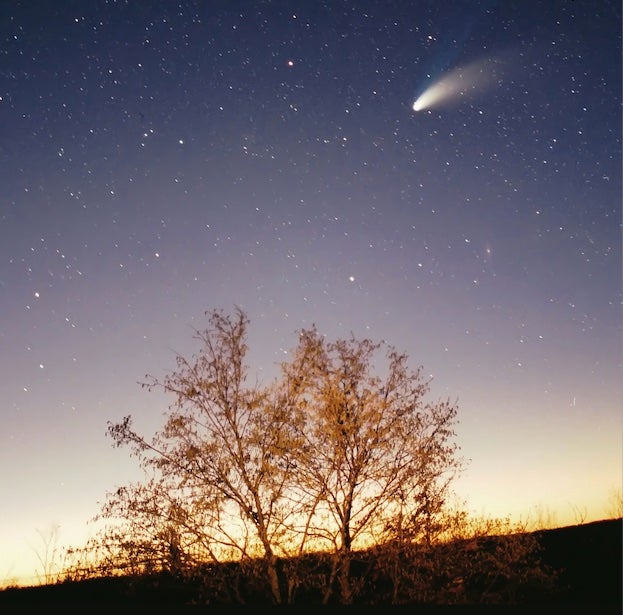
Every so often, a comet, an icy visitor from deep in the outskirts of the solar system, comes hurtling toward the Sun on a long orbit, dazzling us with the apparition of its ghostly coma and long, shimmering tail. How do these comets get their names? It depends.
Sometimes these visitors make only one pass within a period of eons, and other times, such as with the famous Halley’s Comet, they appear regularly enough that you might even get to glimpse the same comet twice in a lifetime.
Regardless of the frequency of their visitation, comets all share a few major details in common. Often referred to as “dirty snowballs,” comets are essentially clumps of ice and dust left over from the formation of the solar system. In the early solars system they accreted into a single chunk due to gravity, and they are often in elliptical orbits, paths that deviate from a circle. Most display long, beautiful tails of gas and dust as they approach the Sun due to the solar wind and radiation pressure.
Humans have observed, admired, and sometimes feared these ghostly apparitions for thousands of years. Indeed, recorded observations of comets go back about as far as any other astronomical data. What has not remained constant through all this time, though, is the conventions by which comets are named.
Some comets, particularly ones which reappear with enough frequency and display enough brightness to be studied without telescopes, have carried names which relate to their time of discovery, their discoverers, or those who studied them. Examples include the aforementioned Halley’s Comet, which became better understood following the work of Edmond Halley in the 17th century, and the Great Comets of 1680 and 1882, which lit up the night sky in those years, respectively.
The meaning of ‘C’ and ‘P’ comets

This convention held sway for much of the history of astronomy. Even a well-known comet like Hale-Bopp, discovered by Alan Hale and Thomas Bopp in July 1995, was still named in this fashion prior to being redesignated as “C/1995 O1.”
What does nomenclature like C/1995 O1 mean, anyway? It’s a code meant to impart knowledge about the comet’s discovery and orbit. In the case of Hale-Bopp, the “C” means that the comet is on an open or “non-periodic” orbit. This means that it will either veer out into interstellar space after coming near to the Sun, or will not reappear in our skies for many thousands or tens of thousands of years.
“P” comets, on the other hand, are periodic, meaning that their orbits are regular enough to be predicted with at least an acceptable margin of error. A classic example is Halley’s Comet, which reappears about every seventy-five years. Its official designation is 1P/Halley. This old favorite last dazzled the world in 1985/1986, meaning it will reappear at its brightest in mid-2061.
Some comets get ‘X’ or ‘D’ designations
Several other cometary prefixes also exist: “X,” for comets which lack orbital data; “D,” which is for a comet that has been lost, and includes the famous Shoemaker-Levy 9 (D/1993 F2) discovered shortly before it hit Jupiter in 1994; “A,” which is used when something has been misidentified as a comet (such as the famous interstellar asteroid ‘Oumuamua, A/2017 U1); and “I,” which was added to the list in 2017 to allow reclassification of ‘Oumuamua, and which includes only one other entry (Comet Borisov, 2I/2019 Q4) in its tiny pantheon.
The first part of the code following the backslash is easy enough: it’s the year of discovery, or in the case of historic comets, the year that their study was standardized (Halley’s Comet, which is designated according to its most recent apparition prior to Edmond Halley publishing his data which concluded it was periodic).
A few other systematic devices are used to delineate comets, such as the leading number, which indicates which order the comet was discovered in its specific category. For example, 1P Halley (Halley’s Comet) was the first comet identified as periodic, whereas 105P/Singer Brewster is the 105th.
This system is intended to make it relatively easy for comets to be understood, tracked, and studied. Whether or not such codes are needed in the modern era is up for debate, but what is clear is that the study of these amazing visitors will continue to be a subject of interest for people of all ages, even as the technology with which to study them continues to advance.









